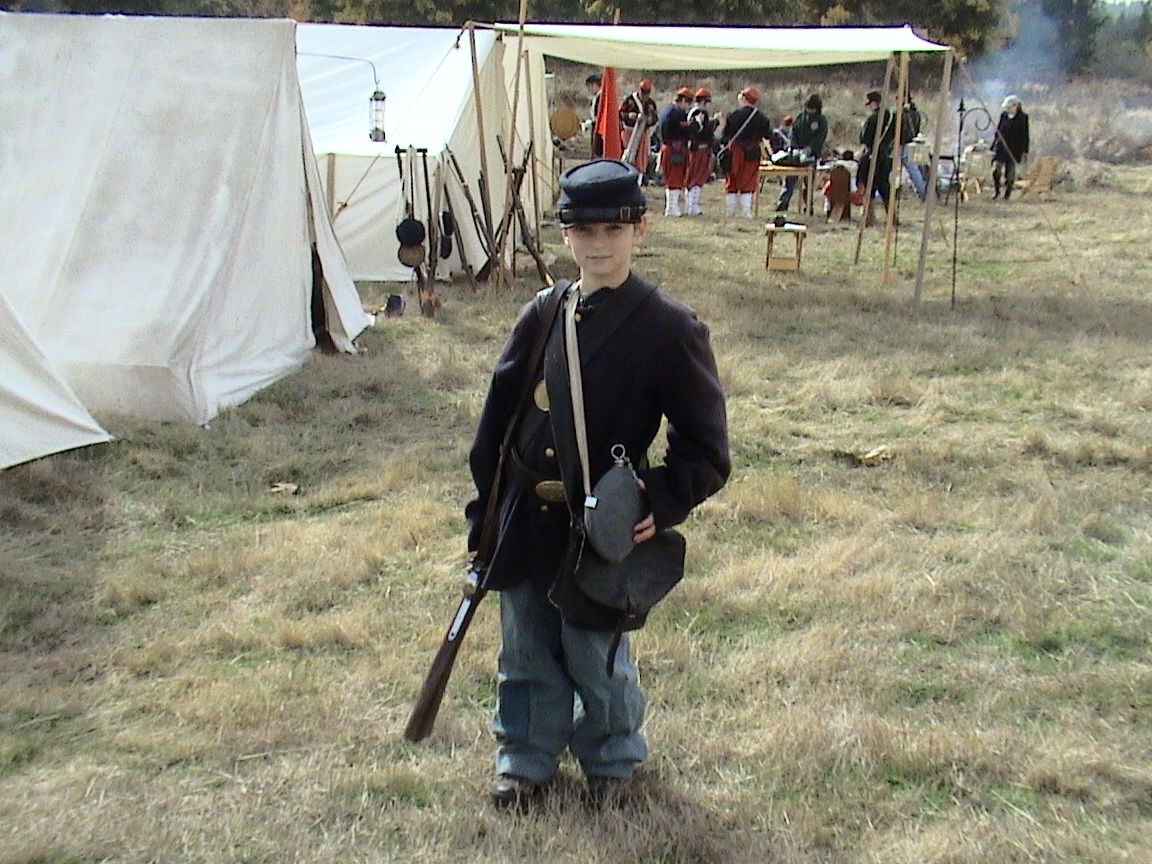Becoming a Civil War Reenactor

With a lot of imagination, a little research, and a modest financial investment, you could begin the unique and satisfying hobby of Civil War Reenactor
By Catherine McNiff
 Young Civil War Reenactor (photo by D. Farr). Related Links |
Children were active participants in the Civil War. While the majority of soldiers were in the 18–40 age range, in many enlistment cases birth years were overlooked, or were fabricated. For official duties, these youngsters—often between 10 and 14—were called on to fill supporting roles such as drummers, buglers, messengers, and field assistants.
Who Will You Be?
Being a Civil War reenactor is about stepping back in time to create believable character—persona—or what reenactors call an “impression“. You must have a passion for history and an active imagination. Reenactors take their “jobs“ very seriously. If you are up to the task, here's some information to get you started.
- 1. Think philosophy. Pick the side you want to “fight“ for.
- 2. Think geography. Choose a regiment within a reasonable distance from home and contact a member. They will be able to answer any questions you have (such as “Does your regiment have a minimum age requirement?“) and provide you with a basic understanding of time and financial commitment involved.
- 3. Think research! Begin collecting and creating your historical identity. You will be expected to dress and act in a manner appropriate of the time.
- 4. Think supplies! You will need to visit a sutlery (supply store run by a civilian, a “sutler“), either online or in person, in order to get your basic gear, called a “kit“. Here is a sampling of an infantry soldier's kit from the website of the 28th Massachusetts, Volunteer Infantry, 4th Regiment, Irish Brigade:
- Federal issue forage cap (dark or indigo blue)
- State issue forage cap with McDowell visor (dark or indigo blue)
- Federal fatigue blouse ("sack coat," dark or indigo blue) with four brass buttons
- Federal trousers, foot pattern (sky blue)
- Issue muslin shirt (or other period pattern)
- Issue socks (gray or rag wool)
- Issue M1851 Jefferson brogans (shoes)
- USM1855 cartridge box, .58 caliber, mid-war model (black leather)
- Cartridge box sling (black leather)
- US oval cartridge box plate (brass)
- US round eagle box sling plate (brass)
- USM1856 waist belt (black leather)
- US Oval waist belt plate (brass)
- USM1855 bayonet scabbard (black leather, one-piece Springfield style)
- USM1850 Cap pouch (black leather)
- M1853 three-band .577 caliber Enfield rifle musket and bayonet
- Musket sling for M1853 Enfield (untreated leather)
- Haversack, U.S. regulation wartime issue (black tarred canvas)
- USM1858 smooth side canteen (jean cloth or dark blue wool cover) with strap (leather preferred over cotton drill or linen)
A basic infantryman's kit can be assembled starting around $1,000, but once you start adding in costly replica weapons and period-authentic accoutrements—or you have your heart set on being a cavalry officer—you could easily spend many thousands. Don't be overwhelmed! Most reenactors collect their kit over a period of time, borrowing from generous fellow soldiers until they are fully outfitted. Other less expensive options are impressions of a civilian water boy, drummer boy, messenger, or just a regular kid—they were certainly, if unfortunately, caught up in the war.
What Will You Do?
Reenactors generally participate in three types of events:
Battle reenactments are scripted recreations of actual Civil War engagements, which spectators pay to come and watch. The troops do their best to mimic the movements of the actual battle, but as in real war, things often don't go according to plan! Reenactments vary greatly in size, with events in New England typically showcasing 100–500 infantry, while the 150th anniversary of Gettysburg in 2013 is expected to field more than 15,000 reenactors, plus thousands of civilian interpreters, 400 horses, and 100 cannon.
Living history events include encampments, parades, and school enrichment programs. Encampments allow visitors to wander through a Civil War camp and observe soldiers training, resting, playing, and simply relaxing—all without television, iPods, or computers!
Tacticals are unscripted battles which are usually not open to the public. These events help reenactors immerse themselves in the reenacting experience, gaining first-hand knowledge of war, battle strategy, and the hardships of combat.
Now and Later
Being a reenactor can not only put you in touch with your inner soldier, drummer, or fifer, but can also deepen your understanding of our country's past. Living like a person in 1863, even if only for a few hours or a few days, would surely sharpen your skills as a historian, actor, and citizen.







